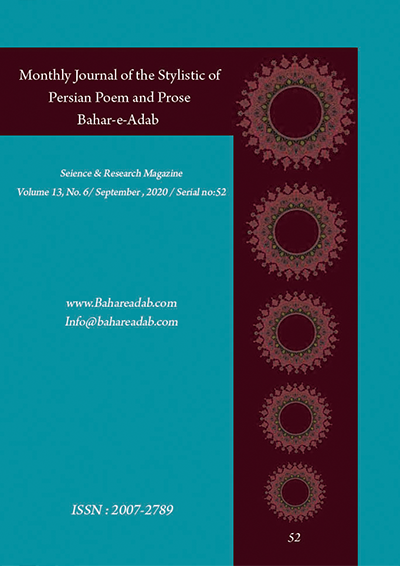- Count View : 490
- آدرس کوتاه شده مقاله: https://bahareadab.com/article_id/972
Journal of the stylistic of Persian poem and prose
volume Number 13،
number In Volume 6،
،
issue Number 52
An overview of the transformation of Mey on a continuum from structuralism to discourse semiotics
Aslan ostovari , Mohammad Reza Amini (Author in Charge)
Abstract
The present study aims to investigate the concept of wine (Mey in Persian) as a fundamental concept in Persian lyric literature focusing on the most important transformations in the poems of Rudaki, Sanaie, Nezami, Atar, Molavi, and Hafez. As discourse semiotics is studied within the evolution of structuralism, this study, with an emphasis on the structuralism view, first investigates the evolution of Mey based on the syntagmatic, paradigmatic and contrastive relations and then using discourse semiotics, it deals with the meaning boundaries to show the evolution path of Mey as one of the most fundamental concepts in Persian lyric poetry. The reason for considering such a continuum in the investigation of Mey (from word study to discourse analysis) is that such fundamental concepts are not merely the words which are used only for naming and referencing, but they change into a complicated integration and floating signifier and have a profound connection with the poet"s lived discourse. They are on a continuum from meaning boundaries of reference to the interactive and ultimately to the melting in evolution.
Keyword
Mey
, structural semiotics
, discourse semiotics
, syntagmatic
, paradigmatic
, contrast
- Saboor, Danesh (2005), Afagh Ghazal Farsi, Tehran: Zavar
- Mohabbaty, Mehdi (2009), From Meaning to Face, Tehran: Sokhan
- Pourjavadi, Nasrollah (2008), The Wind of Love: A Study of the Meaning of the Wind in Persian Mystical Poetry, Tehran: Karnameh
- Shoghi Nobar, A. (2004), Mystical Wind in Hafez's Divan, Kayhan Andisheh, No. 53
- Tajbakhsh, A. and Izadi, A. (2016), Badeh Satayi Abu Nawas and Hafez, Journal of Literary Criticism and Rhetoric, Volume 5, Number 2, Page 4
- Hadi, R. and Seyed Ghasem, L (2013), A Study of the Similarities between Abdolgahir Jorjani's Theories and Structuralism and New Criticism, Journal of Rhetorical Studies, No. 7, p. 127
- Gholizadeh, H. and Khosh Taslikeh, M (2008), Badeh and May and its interpretations in Persian mystical poetry, Institute of Humanities, Volume 6 Number 23 Page 147
- Mansoori, F. (1976), Wind spraying on soil and other customs that the blessed Iranian culture did not accept, Gohar MagazineNo. 48 p. 946
- Chehri, Ta and Salemian, Gh and Yari Gol Darreh, S (2013), Analysis of lexical contrasts and contradictions in Sanai poetry, Research in mystical literature (Gohar Goya), seventh year, number 2
- Tahmasebi, Farhad (2016), Sociology of Persian Ghazal, Tehran:Elmi
- Nezami Ganjavi, Elias (2008), Khamseh Nezami, based on Moscow Press, Tehran: Hermes
- Safavi, Kourosh (2008), An Introduction to Semantics, Tehran: Surah Mehr
- Pournamdarian, Taghi (2009), In the Shadow of the Sun, Persian Poetry and Deconstruction in Rumi's Poetry, Tehran: Sokhan
- Akrami, M. and Abedi, M. (2005), In the heart of the nature of the wind with the elixir of knowledge with committed and idealistic literature, Journal of the Faculty of Literature and Humanities, University of Tabriz, Volume 48, Number 197,
- Hafez, Shamsuddin Mohammad (1375), Divan, by Khatib Rahbar, Tehran: Safi Alishah
- Roudaki Samarkandi (1373), Divan, based on the version of Saeed Nafisi, Tehran: Negah
- Rumi, Jalaluddin Mohammad (1370), Divan Shams, Tehran: Elmi
- Attar Neyshabouri, Fridaldin (1983), by Taghi Tafazoli, Tehran: Scientific and Cultural
- Taslimi, Ali (2005), Khayyam Quartets Theory of Quantity of Time, Tehran: Ameh Book
- Ahmadi, Babak (2001), Text Interpretation Structure, Tehran: Markaz
- Moin, Mohammad (1326), Mazdisna and its impact on Persian literature, Tehran: University of Tehran
- Hamidi, Kh., Critique of Khumriyah Sarai in Roudaki, Manouchehri, Attar and Khaghani Divans, Kashan: Kashan University (2013)
- Mohammadi Asyabadi, Ali (2008), Hermontics and Symbolism in Shams Ghazals, Tehran: Sokhan

